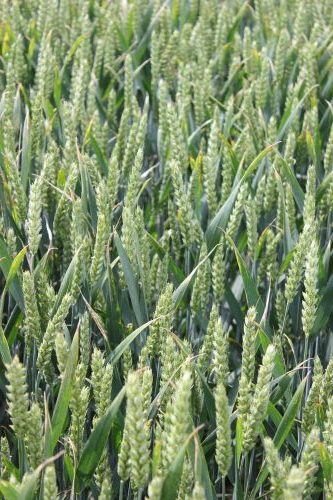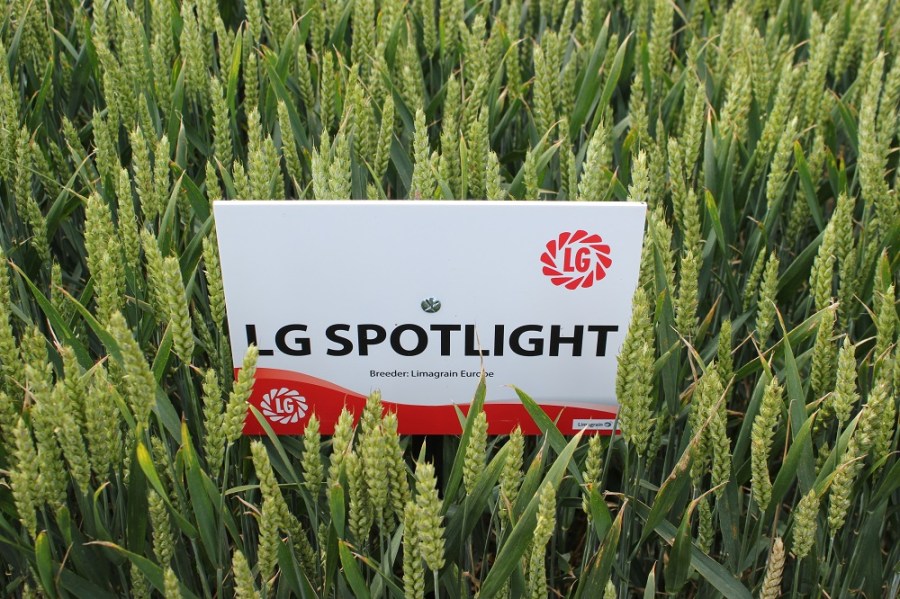Some shy away from the spotlight, and others embrace it. When it comes to the latest wheat from Limagrain – LG Spotlight – it stands tall in the latter category. CPM tells all.
It ticks a lot of boxes in terms of grain quality, straw and as a whole crop option.
By Melanie Jenkins
Continuing from the success it saw with LG Skyscraper, Limagrain’s next highest yielding soft Group 4 feed wheat, LG Spotlight, could be set to provide farmers with a clean sweep of appealing characteristics.
Newly instated on the AHDB Recommended List, LG Spotlight sits just behind its stable mate in terms of yield, but it might just have the upper hand when looking at the overall package.
A product of Scribe x Horatio, LG Spotlight has good grain characteristics in its parentage, according to Phillip Tailby of Limagrain. “One of the older varieties now, Horatio was a soft wheat that had very good grain characteristics, which is one of the standout features of LG Spotlight with a specific weight of 78.3kg/hl. It’s the second highest of any feed and is up there with the Group 1 quality wheats.”

LG Spotlight performs best as a first wheat on heavier land.
LG Skyscraper came onto the market last year and set a new standard for soft wheat yields, putting them ahead of hard wheats, says David Leaper of Agrii. “We saw in recent history that Robigus moved the goal posts and perceptions have again been changed with LG Skyscraper. Now Limagrain has brought in LG Spotlight in its wake.”
Jonathan Baxendale of Wynnstay thinks the variety looks to be a very tidy option for growers. “We see it as being a part of the feed market as it has the joint second highest yield of any variety in the West, as well as good standing power, excellent specific weight and it’s one of the tallest, while also being stiff-strawed. It ticks a lot of boxes in terms of grain quality, straw and as a whole crop option.”
LG Spotlight is slightly back on LG Skyscraper but it has better standing ability, according to David. “We don’t see standing as problematic in LG Skyscraper, but obviously, having something with stiffer straw has to be a good thing.”
It has very high yields and good bold grain, as well as a really high Hagberg, which is obviously an advantage, he adds. “You don’t tend to think about Hagberg as an issue with hard feeds, but if you think about the issues of sprouting – especially those grown further north – then having a high Hagberg can give reassurance to the grower going into catchy autumns or summers.”
During official testing, the Hagberg was very consistent, explains Phillip. “It was very stable and has incredibly low levels of sprouting, so if we have a wet harvest, this certainly helps.”
However, its second wheat performance isn’t as exciting, according to David. “We’d position it as a first wheat across all soil types, but its performance drops away on lighter land, so it’s better suited to heavier soils. Its speed of development also indicates that it’s not really suited to early drilling, but it’ll go through to the end of Oct,” he adds. “It’s not ideal for late drilling either, despite having mid-Feb listed as its latest drilling date.
“Despite being a fast-developing variety, it’s not particularly competitive against grass weeds, so in a high-pressure environment, position it where there are less weed issues,” he adds.
Like LG Skyscraper, LG Spotlight is relatively tall, says David. “It’s stiffer and is one of the tallest varieties we’ve been looking at. We’re happy with it and its response to PGRs, but as people have generally moved to Oct drilling, we’d suggest using a reasonably robust programme, particularly on more fertile soils.”
When it comes to harvest, it’s a mid-maturing variety, which is something people want, adds David. “It’s slightly earlier than the norm and is less prone to sprouting.”
Phillip notes that it has a ripening score of +1. “We’re starting to move away, or buck the trend, of high yielding varieties that get later and later.”
Though its yellow and brown rust scores are better than average, its septoria rating is pretty average, stresses David. “Of the other varieties in that Group, there are several with a weakness for yellow rust, but LG Spotlight holds up really well. While brown rust is another disease proving difficult to control with variety choice, in our own ratings LG Spotlight is one of the best soft feeds for it.”
Wynnstay has LG Spotlight in its own trials and will be displaying it at its Arable Event in June. “Agronomically it looks tidy and though there are varieties with better septoria ratings, when you take into account its full package – particularly its yield and grain quality – you’ll struggle to beat it,” says Jonathan. “In high-pressure situations, its septoria score could potentially put growers off, but it has a similar rating to other popular varieties that have sold well – so it shouldn’t really be a barrier.”
Its good resistance to fusarium ear blight is also very useful, particularly in the West, says David. “We’ve seen a relatively good level of fusarium resistance, and it’s the sort of variety that could be put in after maize, which we know returns high levels of fusarium to the soil, so unlike a milling wheat, it could be a good positioning for LG Spotlight.”
LG Spotlight also has orange wheat blossom midge (OWBM) resistance, says Phillip. “With dwindling chemistry, this is something we’ve bred into many of our candidates and forthcoming lines – it’s an extra support for the farmer.”
The variety meets medium distilling requirements, which is a great asset for the Scottish market, says David. “We’ve been struggling with distilling wheats in the North, so it’s a big step forward for this area.”
However, LG Spotlight sits firmly as a feed variety in the South as it’s currently not uks approved for export, says David. “That’s not to say it couldn’t be blended but there’s no obvious green light. Not having it removes a little bit of flexibility for those who are near ports but then again the export market for soft wheats isn’t what it was 20 years ago.”
Having two varieties in that soft feed sector, which hasn’t always been the biggest group, is significant, says David. “Hard feeds take 50% of the wheat acreage and probably a bit more when you consider that a lot of Group 1s are grown for hard feed. Biscuit and distilling wheats take 20% and soft feeds around 10% of the market.”
Jonathan points out that the West is predominantly a feed growing area, but LG Spotlight is still well suited. “We’re now seeing soft Group 4s competing with hard Group 4s – so it’s becoming a standard feed wheat group that can achieve similar results.”
However, its position on farm does pose a few questions for growers as soft and hard wheats do have to be kept separate on the heap, explains David. “Growing for out-and-out yield is one thing but storage is another. So this will depend on the farm.”
This year LG Spotlight will be a sell-out, according to David. “It’s selling well, so it will sell out, but next year there will be a much bigger production.”
It’s got the potential to take at least 4% of the entire wheat area planted, says Jonathan. “We’re thinking that it’ll be a good variety in our portfolio so we will have stock available. There are so many varieties with good agronomic packages but we’re expecting good things from this.
“If any varieties struggle this harvest, LG Spotlight might be there to pick up the market share,” he adds.
So where is Limagrain heading next? “Our programme is evolving as new technologies become available,” explains Phillip. “We’re looking producing stable, high yielding varieties to get to market quick and offer farmers something new. Yield is still a high priority but we’re certainly looking at yield stability and grain quality – something in which LG Spotlight and LG Skycraper have already shown a step up.”
LG Spotlight has a lot of positive factors to it, whether for livestock growers wanting straw, good grain quality or to grow after maize, as well as having distilling potential, says David. “We see it as quite an interesting choice as it can be used in any arable situation.”
Spotlight impresses in Leics
Farming 700ha in partnership with his father, John, and brother, Mark, Keith Wells grows wheat, oilseed rape, spring beans, herbage seed and winter linseed at Burbage Farms, Leics.
He first planted LG Spotlight in 2017 as a seed crop for Limagrain. He drilled 19ha on 10 Oct at a rate of 135kg/ha using a 4m Väderstad Rapid behind a two-year ryegrass ley. Some parts of the field were drag- or power-harrowed after ploughing, with the seed rolled after sowing. “We describe ourselves as medium loam, with a glacial drift, from sand to heavy clay. We can’t treat every field with the same cultivations because of the different soil structures.”
Despite suffering a little bit of slug damage – a regular issue after ryegrass – it established very nicely, says Keith.
In the autumn it had sewage cake applied, followed by Liberator (flufenacet+ diflufenican) and Lexus SX (flupyrsulfuron methyl) as a pre-emergent herbicide, then some potash later in Nov.
In spring it always looked good, says Keith. “We tend to find this when we put sewage cake on, which is why we use it as much as we can.” It didn’t have a T0 but at T1 on 4 May it had Seguris (epoxiconazole+ isopyrazam), Bravo (chlorothalonil) and a dose of chlormequat.
At T2 on 24 May it had Ceratavo Plus (benzovindiflupyr), Daconil (chlorothalonil) and Epic (epoxiconazole) at flag leaf stage followed by an ear spray of Prosaro (prothioconazole+ tebuconazole). “Though it hasn’t got the best septoria ratings, our fungicide programme kept it out very well and septoria is something we suffer with more than anything else.”
In terms of fertiliser, it had two doses of N; one of 92kgN/ha on 20 April and another at 130kgN/ha on 9 May.
“Bearing in mind it was a drought year, it yielded a respectable 9.5t/ha in the third week of Aug. This isn’t as much as we’d normally expect from our farm – we were a good half a tonne down on what we’d have liked – but it was one of our best yielding wheats that year,” explains Keith. “It was a lovely crop to look at. It was very clean and had good broad leafiness.”
As a result, Keith decided to grow more LG Spotlight. He currently has 18ha in the ground for Limagrain and 39ha as a commercial crop for himself. It was treated similarly to the previous year’s crop, but didn’t have sewage cake on it. The seed crop had an NPK dressing of 7/18/36 as a pre-emergent in the autumn, and then ammonium sulphate in the spring, delivering 55kg SO3/ha and 19.5kgN/ha. Then at the end of March it had 85kgN/ha and 70kgN/ha in late April.
The herbicide applications were the same as the previous year but Keith altered his fungicide programme slightly. At T0 it had a split of chlormequat and Bravo, then at T1 it had Epic, Ceratavo Plus and chlormequat. “It’s had a slightly heavier fungicide programme than last year but the crop looks well and I want to look after it.
“The seed crop didn’t tiller as well as last year, but the commercial crop was behind spring beans and OSR and this has tillered a lot more,” says Keith. “It looks very well and clean and I’m pleased with it. My brother has marketed it and it’s sold very well, so we’ll see. But we’re happy so far.”
LG Spotlight at a glance





